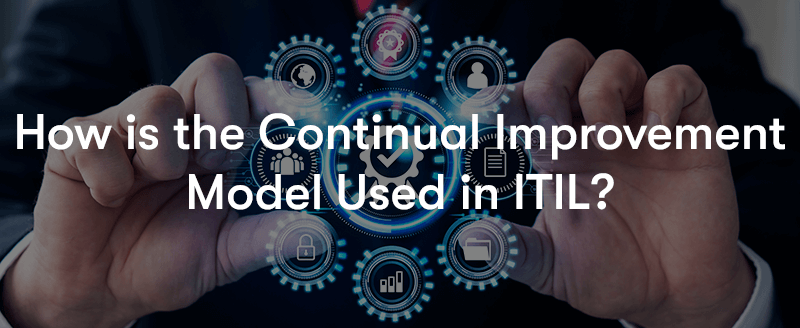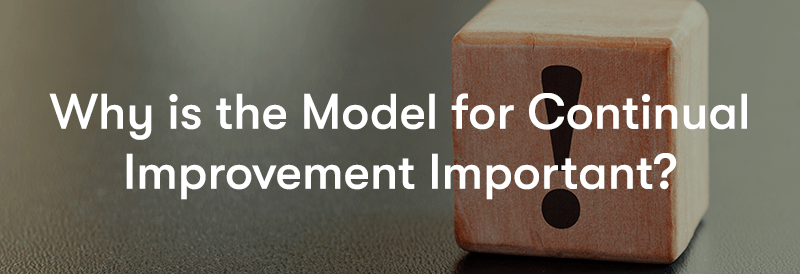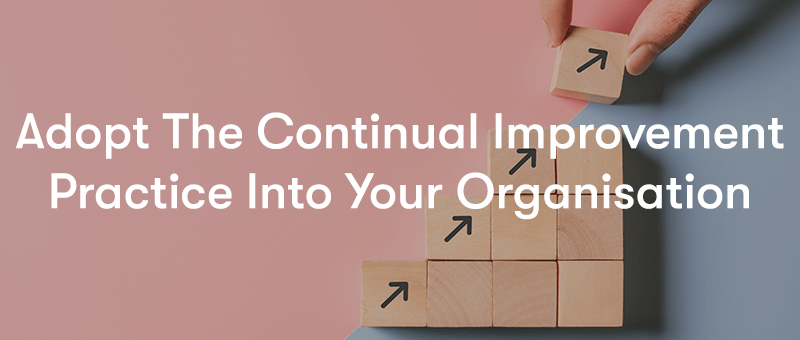ITIL 4 is a widely recognised framework for IT service management. Continual Improvement is one of the key practices in ITIL 4 that focuses on continuously enhancing the quality of IT services, processes, and practices within an organisation. It emphasises the importance of constantly reviewing and improving all aspects of service delivery to meet changing business needs and customer expectations.
ITIL® Continual Improvement
ITIL 4 Continual Improvement is a key concept in IT service management that focuses on enhancing the quality and value of IT services over time. It emphasises a proactive and iterative approach to improvement, aiming to meet evolving business needs and customer expectations. ITIL 4 Continual Improvement practice follows this methodology:
- Understand the vision
- Start where you are
- Define improvement opportunities
- Prioritise improvements
- Develop a business case
- Implement improvements
- Measure and evaluate
- Review and learn
By following the ITIL 4 Continual Improvement practice, organisations can drive ongoing enhancements in their IT services, processes, and practices, leading to increased efficiency, customer satisfaction, and overall business value. The goal is to create a culture of continuous learning and improvement within IT organisations, driving better performance, efficiency, and customer satisfaction.
You may be wondering why we use the word ‘continual’ rather than ‘continuous. The word 'continuous' refers to something that happens without interruption or ceasing, like the flow of a river. 'Continual' refers to something that recurs frequently or regularly, like showers of rain. The reason is that we don’t undertake continuous improvement is that people would simply get ‘burnt out’ with continuous change. They require periods of stability to embed, stabilise and review the current improvements before moving on to the next round of improvement.
What is the ITIL Continual Improvement Model?

The ITIL 4 Continual Improvement practice is based on the Plan-Do-Check-Act (PDCA) model, also known as the Deming Cycle or the Shewhart Cycle. It involves the following key activities:
Understand the vision
Organisations need to define their strategic goals and objectives. This includes understanding the vision and direction of the business and identifying the areas where improvements are required. It helps in aligning improvement initiatives with business objectives, identifying gaps, fostering a culture of improvement, and creating long-term plans. This requires close collaboration and communication between IT and the business stakeholders. By keeping the vision in focus, organisations can drive meaningful and impactful improvements in their IT services.
Start where you are
Organisations should assess their current state by conducting a baseline assessment. This involves evaluating existing processes, services, and capabilities to identify strengths, weaknesses, and areas for improvement. This step allows realistic and practical starting point for their improvement journey.
Define improvement opportunities
Once the current state is understood, improvement opportunities are identified. This can be done by analysing data, customer feedback, and industry best practices. The identified opportunities should align with business objectives. It is essential to keep an eye on industry trends and emerging technologies that can impact IT services and practices. By analysing these trends, organisations can identify opportunities to leverage new technologies or adopt emerging practices. Involving stakeholders, including IT staff, customers, and end-users, is crucial in defining improvement opportunities. By seeking input from stakeholders, organisations can gain diverse perspectives and insights. It is also important to consider regulatory and compliance requirements, identifying gaps or areas of non-compliance helps ensure adherence to legal and regulatory requirements.
Prioritise improvements
Organisations need to prioritise improvement initiatives based on their impact and feasibility. This ensures that resources are allocated effectively and focuses efforts on areas that will provide the greatest value. Organisations need to evaluate the potential impact of each improvement opportunity. This involves considering factors such as the expected benefits, both tangible and intangible, that would result from implementing the improvement. You should conduct a cost-benefit analysis for each improvement opportunity. This involves estimating the costs associated with implementing the improvement and comparing them to the expected benefits. Conduction a risk assessment for each improvement opportunity is crucial for prioritisation. Organisations need to consider potential risks, challenges, and uncertainties that may arise during implementation.
Develop a business case
A business case is created to justify and support improvement initiatives. The business should start by clearly articulating the problem or opportunity that the improvement initiative aims to address. It should then outline the expected benefits, costs, risks, and resources required for each improvement opportunity. This helps in gaining support and approval from stakeholders. The business case considers the perspectives and interests of various stakeholders. It identifies key stakeholders who will be impacted by the improvement initiative and outlines strategies for engaging and communicating with them.
The business case also serves as a tool to secure the necessary resources, support, and approvals to move forward with the initiative. It also provides a framework for evaluating the success of the improvement and measuring its impact on the organisation's objectives and desired outcomes.
Implement improvements
Before implementing improvements, organisations need to create a comprehensive implementation plan. It is important to assign project management and governance roles to ensure effective execution of the improvement initiatives. This includes designating a project manager or a project team responsible for overseeing the implementation process.
Next is time to execute the improvement initiatives. This may include activities such as deploying new technologies, modifying processes, training staff, or redesigning service delivery workflows.
As improvements are implemented, it is important to document the changes made to processes, systems, or service delivery. This documentation helps create a knowledge base that can be used for future reference, training, or auditing purposes.
It is important to note that communication and stakeholder engagement are crucial during the implementation phase. Regular communication and engagement sessions help manage expectations, address concerns, and ensure a smooth implementation process.
Measure and evaluate
Organisations need to establish appropriate metrics and key performance indicators (KPIs) to measure the effectiveness of the implemented improvements. They provide quantitative or qualitative data that can be used to measure the desired outcomes. KPIs should be specific, measurable, attainable, relevant, and time-bound (SMART).
Once the data is collected, it needs to be analysed to derive meaningful insights and evaluate the impact of the improvements. Data analysis may involve statistical analysis, trend analysis, comparative analysis, or any other relevant analytical techniques. The analysis aims to identify patterns, trends, correlations, or anomalies in the data, providing insights into the effectiveness of the implemented improvements.
The evaluation process should assess the outcomes and benefits achieved as a result of the implemented improvements. This includes measuring the extent to which the improvement initiatives have met the defined goals and objectives.
It is essential to communicate the results of the measurement and evaluation process to stakeholders and relevant parties. This includes sharing the findings, insights, and recommendations derived from the analysis.
Measuring and evaluating improvements is an iterative process. As the organisation progresses in its improvement journey, it is important to continuously refine the measurement approach such as KPI’s and analysis methods.
Review and learn
“Continually improve the Continual Improvement Model.” – Steve Lawless
Continual Improvement is an iterative process, and it is crucial to review the results of implemented improvements regularly. Lessons learned from previous improvement initiatives should be documented and shared across the organisation to foster a culture of learning and continuous improvement. This involves encouraging knowledge sharing, promoting collaboration, and creating mechanisms for capturing and disseminating best practices and lessons learned across the organisation. By continuously learning and adapting, organisations can stay agile, innovative, and responsive to changing business needs and emerging opportunities.
What Are the Benefits of ITIL Continual Improvement Model?

The benefits of ITIL 4 Continual Improvement are numerous and significant. Here are some key advantages:
Enhanced service quality
Continual Improvement helps organisations identify and address service deficiencies, leading to improved quality and reliability of IT services.
Increased customer satisfaction
By continuously aligning services with customer needs and expectations, organisations can enhance customer satisfaction and build stronger relationships.
Improved efficiency
Continual Improvement promotes the elimination of waste, streamlining processes, and optimising resource utilisation, resulting in increased efficiency and productivity.
Better decision-making
Through ongoing evaluation and analysis, Continual Improvement provides valuable insights and data-driven information, enabling informed decision-making for future improvements.
Greater agility and responsiveness
The iterative nature of Continual Improvement allows organisations to adapt quickly to changes in business requirements and market conditions, enhancing their agility and responsiveness.
Cost optimisation
By identifying and eliminating unnecessary activities and optimising resource allocation, Continual Improvement can lead to cost savings and better financial management.
Continuous learning culture
Embracing Continual Improvement fosters a culture of learning, innovation, and collaboration within the organisation, encouraging employees to constantly seek better ways of working.
Competitive advantage
Organisations that actively practice Continual Improvement gain a competitive edge by continuously enhancing their services, meeting customer demands, and staying ahead of the competition.
How Does Continual Improvement Relate To Other ITIL 4 Practices?
The ITIL 4 continual improvement practice is unique in a way, it relates to every one of the 34 practices. It even relates to itself. Is a method, an approach, and a culture within an organisation to improve, well, everything.
How is the Continual Improvement Model Used in ITIL?

Continual Improvement is a fundamental concept and practice in ITIL 4 that is applied across all stages of the ITIL service lifecycle. It is used to drive ongoing improvements in IT services, processes, and practices to meet changing business needs, enhance efficiency, and deliver value to customers. Here's how Continual Improvement is used in ITIL 4:
Vision and Strategy
Continual Improvement starts with understanding the organisation's vision, goals, and strategic objectives. It ensures that improvement initiatives are aligned with the overall business strategy, enabling IT to contribute effectively to achieving business outcomes.
Governance and Management
Continual Improvement is integrated into the governance and management practices of ITIL 4. It provides a framework for establishing policies, guidelines, and mechanisms for monitoring, measuring, and governing improvement initiatives across the organisation.
Service Design and Transition
In the service design phase, Continual Improvement is used to design and implement IT services and processes that are flexible, adaptable, and responsive to future changes and improvement opportunities. It ensures that service improvements are built into the design and transition of new or changed services.
Service Operation
Continual Improvement is applied to monitor and measure the performance of IT services and processes in the operational environment. It involves regular assessments, analysis of metrics, and feedback from stakeholders to identify areas for improvement and take proactive actions to enhance service quality and efficiency.
Service Strategy
Continual Improvement is used to evaluate the effectiveness of service strategies and make necessary adjustments to align them with changing business requirements. It ensures that service strategies are continuously reviewed, updated, and refined based on feedback and lessons learned.
Service Improvement Initiatives
Continual Improvement guides the identification, prioritisation, and implementation of specific improvement initiatives. It involves assessing improvement opportunities, developing business cases, implementing changes, and measuring the impact to validate the success of the initiatives.
Measurement and Evaluation
Continual Improvement emphasises the measurement and evaluation of IT services, processes, and practices to assess their performance, identify areas for improvement, and measure the achieved outcomes and benefits. It includes defining and monitoring key performance indicators (KPIs), analysing data, and conducting regular reviews and assessments.
Knowledge Management
Continual Improvement fosters a culture of knowledge sharing and learning. It encourages capturing and documenting lessons learned, best practices, and successful approaches to facilitate knowledge transfer and leverage past experiences in future improvement initiatives.
Feedback and Stakeholder Engagement
Continual Improvement involves actively engaging with stakeholders, such as customers, users, and IT staff, to gather feedback, understand their needs, and incorporate their perspectives in improvement efforts. It ensures that improvement initiatives are customer-centric and address their expectations and requirements.
Why is the Model for Continual Improvement Important?

The ITIL framework provides best practices for IT service management. Continual improvement is a core principle of ITIL and is crucial for several reasons:
Enhancing Efficiency
Continual improvement helps organisations identify and eliminate inefficiencies, bottlenecks, and waste in their IT processes. By regularly evaluating and refining processes, organisations can streamline operations, reduce costs, and increase productivity.
Increasing Customer Satisfaction
Continual improvement focuses on meeting customer needs and expectations. By continuously assessing and improving IT services, organisations can deliver better quality services that align with customer requirements. This leads to increased customer satisfaction and loyalty.
Adapting to Changing Requirements
In today's rapidly evolving technology landscape, businesses face changing customer demands, emerging technologies, and evolving market conditions. Continual improvement enables organisations to adapt to these changes effectively. It encourages a proactive approach to identify and implement necessary adjustments to IT services and processes.
Driving Innovation
Continual improvement fosters a culture of innovation within an organisation. By encouraging employees to contribute ideas and suggestions, organisations can identify opportunities for improvement and implement innovative solutions. This helps to stay ahead of competitors, drive growth, and explore new possibilities.
Promoting Learning and Development
Continual improvement encourages a learning mindset and professional development among IT staff. It emphasises the importance of ongoing learning, sharing knowledge, and developing skills. This not only benefits individuals but also contributes to the overall competence and expertise of the organisation.
Ensuring Alignment with Business Goals
Continual improvement ensures that IT services and processes are aligned with the strategic objectives of the business. By regularly assessing the performance of IT services, organisations can identify gaps, make adjustments, and ensure that IT supports the overall business goals effectively.
Establishing a Culture of Continuous Improvement
By making continual improvement a part of the organisational culture, organisations create an environment where employees are empowered to identify and propose improvements. It encourages collaboration, communication, and a shared responsibility for ongoing enhancements.
Adopt The Continual Improvement Practice Into Your Organisation

Adopting a Continuous Improvement organisational culture
Senior management is crucial when trying to onboard a continual improvement culture. Senior management should adopt continual improvement and become leaders for the rest of the organisation. From there senior management can monitor, analyse, review and report on adopting the culture.
Adding Continual Improvement Into Your Processes
All processes should be reviewed on a regular basis, at least annually or following any major change to your organisation. It is also important to embed continual improvement into other frameworks and methodologies such as DevOps, Lean, Agile, Six Sigma, and COBIT.
Knowledge Sharing
Sharing knowledge is vital for continual improvement, many organisational cultures view knowledge as a personal asset rather than an organisational one. Sharing across employees and teams helps the organisation benefit and become increasingly more effective and efficient. It must be noted that this knowledge sharing culture must be developed by senior managers.
Continual Professional Development
Continual professional development or continual learning is a massive part of continual improvement. By seeking every opportunity to learn, some important factors are:
- Self improvement.
- Emerging technologies such as Artificial Intelligence (AI) at the moment.
- Best practices changing on a industry level.
- Through training courses you can learn different methodologies and frameworks which could help better your organisation.
- By fostering a mindset of learning, adaptation, and innovation, your organisation can continuously enhance services and processes to meet your ever evolving customer needs.
Where Can You Learn More?
At the moment PeopleCert is developing 15 practitioner courses which cover some of the most important of the 34 practices within ITIL4. So, keep your eye out for the continual improvement practitioner course (which is one of the 15 most important), or sign-up to our newsletter to get notified when it is released!
As of right now there are a few options to learn about ITIL® 4 continuous improvement:

ITIL® 4 Strategist: Direct, Plan & Improve (DPI) provides you with a practical and strategic method for planning and delivering continual improvement with the necessary agility.

The ITIL® 4 Foundation course provides a comprehensive introduction to the ITIL 4 framework, including the principles, practices, and concepts of continual improvement.
Final Notes On ITIL 4 Continual Improvement
In the dynamic world of IT, continual improvement is the heartbeat that keeps organisations thriving. ITIL 4's approach to continual improvement is a game-changer, emphasising the need for ongoing enhancements to meet evolving business demands. By following the Continual Improvement Model, your company can unlock a culture of innovation and efficiency. Feedback and communication ensure that stakeholders are heard and progress is shared. So, let's embrace continual improvement, foster a learning mindset, and watch our IT services soar to new heights of success.
With our ITIL® 4 Foundation course, you can start your ITIL journey and conquer any challenge that comes your way!



